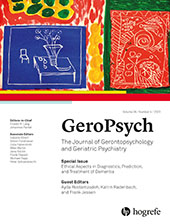The Role of Different Aspects of Communication Behavior in the Assessment of Capacity to Consent
Abstract
Abstract: Any medical treatment that interferes with physical integrity requires the informed consent of a patient capable of such consent. For people with dementia, the capacity to consent is questioned even in the early course of the disease. Particularly diagnostic instruments like the MacArthur Competence Assessment Tool for Treatment (MacCAT-T) often deny people with dementia the capacity to consent because of high confounding of the results with patients’ verbal abilities. To date, it remains unclear whether not only verbal but also nonverbal communication is associated with assessments of capacity to consent. The current study investigates associations between patients’ verbal and nonverbal communication behaviors as assessed by the measure for Communication Behavior in People with Dementia in Ambulant Settings (CODEMamb) and capacity to consent as assessed by the MacCAT-T. We expected the strongest positive associations for verbal communication behaviors compared to nonverbal communication behaviors. Data of N = 43 patients with dementia (n = 8 capable of consent) were collected at two different German psychiatric clinics. The results show small to moderate correlations between the overall scores of CODEMamb and MacCAT-T. As expected, correlations were strongest for the verbal CODEMamb subscale. The results support current findings on the dependency of the MacCAT-T on verbal communication. Based on the findings, the discussion addresses how people with dementia can be enabled to make self-determined medical treatment decisions.
In 2018, there were about 1.6 million people with dementia (PwD) living in Germany, and these numbers are expected to rise to more than 2.7 million persons by 2050 (Alzheimer Europe, 2019). Around the world, about 55 million people live with dementia (WHO, 2021), a number that increases by approximately 10 million per year. On average, a diagnosis of dementia is associated with having 4–6 comorbid diseases (Attems et al., 2006). Consequently, PwD have to make many decisions about medical treatment, while their capacity to do so is simultaneously often questioned.
Capacity to Consent in PwD: Legal and Ethical Considerations
On legal and ethical grounds, every patient has to give their informed consent to medical treatment and thus must be enabled to make a self-determined treatment choice (Trachsel et al., 2018). Capacity to consent is one important prerequisite for informed consent and requires the patient (1) to understand information about their condition and treatment options, (2) to appreciate this information, (3) to reason about it, and (4) to express a choice (Grisso & Appelbaum, 1998). Thereby, the capacity to consent is not a stable personal trait and has to be assessed anew for each decision (Moye et al., 2006; Trachsel et al., 2018).
In contrast, many medical professionals assume that the capacity to consent to medical treatment is not given in PwD already in the early stages of the disease as a consequence of the related cognitive decline and impairments in communication abilities (Kümmel et al., 2014; Marson et al., 1996). However, this is both unethical – with reference to the ethical principle of autonomy (Beauchamp & Childress, 2019) – and illegal according to German law (Haberstroh et al., 2021; see also the AWMF-S2k guideline on capacity to consent in PwD; DGGG, DGPPN, & DGN, 2020) and counteracts the UN Convention on the Rights of Persons with Disabilities. The latter states that persons with disabilities, including PwD, not only have the right to make self-determined choices but also that measures must be taken to enable them to exercise this right (UN-CRPD, 2006; see also German Ethics Council, 2012). Against this background, the German AWMF-S2k guideline on capacity to consent in PwD (DGGG, DGPPN, & DGN, 2020) states that insufficient resource-specific support must be considered as a possible reason for an insufficient understanding of disease- or treatment-related information.
Communication Losses and Resources in PwD
According to the TANDEM model of communication (Haberstroh, Neumeyer, et al., 2011), every piece of information consists of content aspects and relationship aspects. On this basis, Knebel et al. (2016) suggest differentiating between verbal (content) aspects, nonverbal (content) aspects, and (nonverbal) relationship aspects of communication behavior. While (verbal and nonverbal) content aspects transmit information, relationship aspects convey emotions and relations. An instrument developed to measure these three aspects in PwD is the CODEMamb, which uses observational measures of communication behavior in an unstructured conversation and formal testing situations (Knebel et al., 2016).
PwDs’ communication ability becomes increasingly compromised as the disease progresses (Knebel et al., 2016; Kümmel et al., 2014), but this development is not stable over time. For example, the daily profile of communication resources and losses may vary (Haberstroh, Müller, Knebel, Kaspar, et al., 2014; Haberstroh, Pantel, et al., 2011). Most importantly, however, not all aspects of communication are equally affected by the disease. While verbal communication abilities often deteriorate early in the course of the disease (Kümmel et al., 2014), nonverbal content and relationship aspects often remain preserved even into the late stages (Haberstroh, Pantel, et al., 2011; Seidl et al., 2012; Wilson et al., 2012). These variations must be considered when assessing PwDs’ capacity to consent.
The Link Between Assessment of Capacity to Consent and Differential Communication Behaviors of PwD
Unstandardized assessments of a patient’s capacity to consent are influenced not only by the characteristics of the patient but also by the characteristics of the person carrying out the assessment (Haberstroh & Müller, 2017; Hermann et al., 2016). For example, interrater reliabilities in judgments about the capacity to consent in mild dementia have been found to correspond to chance level (Haberstroh & Müller, 2017; Marson et al., 1997).
To avoid this problem, researchers developed standardized instruments like the MacCAT-T (Grisso & Appelbaum, 1998). However, previous findings suggest that these instruments focus on communication deficits, i.e., verbal aspects of communication (Gurrera et al., 2006; Haberstroh, Müller, & Knebel, 2014). Leaving more resourceful, nonverbal aspects of communication unattended, however, would be a source of discrimination against PwD since their capacity to consent may be underestimated. Yet, to date no study has investigated how not only verbal but also nonverbal content and relationship aspects are related to assessments of capacity to consent as measured by standardized instruments.
Study Aim and Hypotheses
The study aims at investigating the role of nonverbal and relationship in contrast to verbal aspects of communication for the assessment of PwD’s capacity to consent. We examine the following hypotheses:
Overall score and individual criteria of capacity to consent have stronger associations with verbal aspects of communication behavior than with nonverbal and relationship aspects of communication behavior.
Exploratory analysis: We assume that PwD capable of consent show more communication behavior than those incapable of consent, but we expect differences to depend on the specific aspect of communication behavior.
Methods
The current study is based on data from the research project EmMa (Förderung der Einwilligungsfähigkeit in medizinische Maßnahmen bei Demenz durch ressourcenorientierte Kommmunikation [Promotion of Capacity to Consent to Medical Treatment Among Persons with Dementia by Means of Resource-Oriented Communication]. For more information on the project, see Haberstroh et al. (2022) and Poth et al. (2023).
Participants
We recruited a sample of N = 46 participants from June 2012 to April 2014 at the patients’ initial appointment at the memory clinics of the university clinics in Heidelberg, Germany, or of the psychiatric clinic in Schlüchtern, Germany. The inclusion criterion was a diagnosis of Alzheimer’s, vascular, or mixed dementia (ICD-code F00.1, F01.- or F00.2) and a prescription of acetylcholinesterase inhibitors. We included the diagnoses listed because they are the most common types of dementia, and because they are similar in the cognitive impairments caused. Exclusion criteria were severe dementia, uncompensated hearing or vision deficits, nonnative German speakers, severe psychiatric illness, and/or neurological symptoms above and beyond dementia.
Study participation was voluntary, and participants did not receive any compensation. We provided information about the study by combining verbal and written information in plain language. The Ethics Committee of the medical faculty of the University of Heidelberg and the Ethics Committee of the Medical Association of Hessen [Ethik-Kommission bei der Landesärztekammer Hessen] gave study approval. All procedures were carried out in accordance with the 1964 Helsinki declaration and its later amendments or comparable ethical standards. We obtained written informed consent from all participants. If a participant had a guardian, both the participant and guardian took part in the written informed consent procedure.
We excluded three participants because of missing data in the target variables. Therefore, the sample used in this study consisted of a total of N = 43 PwD. These participants were aged 58–91 years (M = 76.56, SD = 7.21), and most of them were female (n = 32, 74.4%). Average years of education were M = 9.78 (SD = 3.23; one missing). Most participants had been diagnosed with Alzheimer’s disease (n = 25, 58.1%), followed by mixed-type dementia (n = 15, 34.9%) and vascular dementia (n = 2, 4.7%); for one patient (2.3%), dementia type was missing. In most cases, the dementia severity was classified as mild (n = 30, 69.8%). The average score of the Mini Mental State Examination (MMSE; Folstein et al., 1975) was M = 20.90 (SD = 3.41, range = 13.00–28.00; one score was missing).
Measures
Communication Behavior
To assess participants’ communication behavior, we used the CODEMamb (Knebel et al., 2016). This observational tool assesses communication resources in PwD with subscales for verbal, nonverbal, and relationship aspects of communication.
The items on verbal and relationship aspects are rated after 10 minutes of unstandardized communication (e.g., “She/he uses words according to their meaning.” or “She/he signals the need to communicate.”), whereas the items on nonverbal communication are rated using standardized tasks (e.g., “She/he recognizes pictures that have already been presented despite distractors.”; Knebel et al., 2016). Scoring requires the observer to rate the extent to which a certain behavior was shown on a 6-point Likert scale from 1 = never to 6 = always. Higher values indicate a higher percentage of the respective behavior shown throughout the interaction.
For statistical and content reasons (many missings and poor factor loadings), we excluded 3 of the 19 items from the analysis: 2 items (No. 13 and 14) from the verbal subscale and 1 item (No. 19) from the nonverbal subscale (for further information, see Haberstroh et al., 2022).
For each subscale, we calculated mean scores and transformed them into an overall score of communication behavior. Previous analyses reported the CODEMamb’s internal consistency, interrater, and retest reliability as well as convergent validity as satisfactory to excellent, while divergent validity was rather low. In this analysis, internal consistency was very high for the overall score as well as for the two scale scores of verbal and relationship aspects of communication behavior (Cronbach’s α = .91–.93) and rather low for the nonverbal scale (Cronbach’s α = .46). The scale was retained nonetheless because the small number of items (n = 3) in combination with a rather small number of participants could have systematically reduced Cronbach’s α, particularly since the 3 items measure two different dimensions (comprehension: n = 2; remembering: n = 1).
Capacity to Consent to Treatment
We assessed the capacity to consent to treatment using an adapted German version of the MacCAT-T (Grisso & Appelbaum, 1998; German version by Vollmann, 2008). This semistructured interview is the most-used and best-validated instrument to assess the capacity to consent to a specific medical treatment (Appelbaum, 2007). It takes 20–25 minutes and is divided into nine sections that assess the four relevant criteria (understanding, appreciating, reasoning, and expressing a choice). Originally, each item is rated as either fulfilled, partly fulfilled, or not fulfilled (range: 0–2); then, a sum score per criterion and a sum score for overall capacity to consent are calculated. The dichotomous decision about the capacity to consent (yes/no) is based on cut-off scores for each criterion: Capacity to consent is considered given when a participant meets the cut-off score of each criterion (Grisso & Appelbaum, 1998).
Previous studies showed questionable to very high reliability and sufficient validity of the adapted German version (Müller et al., 2015, 2017). In this study, internal consistency ranged from poor (appreciation: Cronbach’s α = .54) to acceptable (understanding: Cronbach’s α = .77) and good (reasoning: Cronbach’s α = .82, overall: Cronbach’s α = .85).
Design and Procedure
At the first appointment at the clinic, trained psychologists assessed the participants’ communication behavior during the medical history assessment using CODEMamb. At the following appointments, the participants received routine medical and neuropsychological diagnostics for dementia. At the final appointment, the dementia diagnosis was confirmed and communicated to the patients as part of routine treatment. Moreover, participants were informed about the treatment with acetylcholinesterase inhibitors, and the participants’ capacity to consent was assessed by trained psychologists using the MacCAT-T.
Data Analysis
We performed data analyses using IBM SPSS Statistics (version 28). Since most of the data were not normally distributed, we computed nonparametric statistical analyses. To assess the association between participants’ communication behavior and their capacity to consent (Hypothesis 1), we correlated the CODEMamb and MacCAT-T scores using Spearman’s Rho. To assess differences in communication behavior according to capacity to consent (Hypothesis 2), we allocated the participants to one of two subsamples based on their capacity to consent as measured by MacCAT-T dichotomous overall score (capable of consent: cc+; incapable of consent: cc−). Then, we compared the CODEMamb overall and scale scores as dependent variables between groups using Mann-Whitney U-Tests.
The significance level was generally set at α = .05.
Results
Preliminary Analysis: Comparability of Subsamples
Eight participants (18.6%) were rated as capable of consent. As potential socioeconomic confounders, we tested for differences between groups regarding age, gender, and years of education. We found no significant differences between the groups (age: cc+: Mdn = 81.00, range: 74.00–84.00 years; cc−: Mdn = 77.00, range: 58.00–91.00 years, U = 84.50, p = .082, r = .26; gender: χ2(1) = .73, p = .401, Cramer’s v = .13; years of education: cc+: Mdn = 9.00, range: 8.00–17.00; cc−: Mdn = 8.00, range: 8.00–17.00, U = 105.50, p = .335, r = .17).
Associations Between Communication Behavior and Capacity to Consent (Hypothesis 1)
Table 1 presents the results of the correlational analyses. The dichotomously scored criteria of expressing a choice showed little variance, since only n = 2 participants (4.3%) were incapable of doing so. This criterion was, therefore, excluded from further analysis.
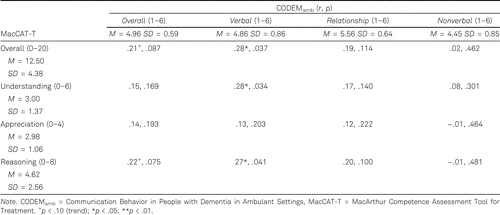
Table 1 shows that the correlations of the MacCAT-T overall and subscale scores with the CODEMamb verbal score were higher than the correlations with the other two CODEMamb subscales. Accordingly, only the CODEMamb verbal subscale showed significant associations with the MacCAT-T overall score and with the criterions “understanding” (p = .034) and “reasoning” (p = .041). However, the nonverbal and relationship subscales were not related to any of the MacCAT-T criteria.
Table 2 shows that the differences between the respective correlation coefficients did not reach significance.
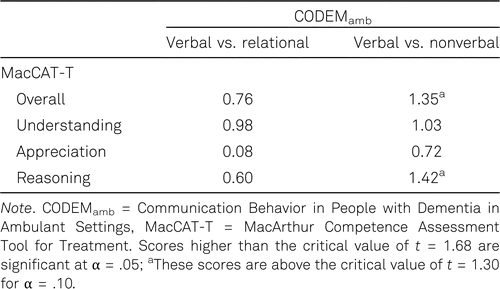
Differences Between Participants Capable and Incapable of Consent (Hypothesis 2)
With this exploratory analysis, we looked at differences in CODEMamb scores between cc+ and cc−. Figure 1 presents the results.
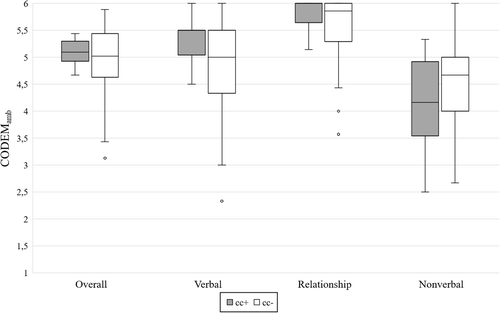
We found no significant differences, neither for the relationship nor for the nonverbal subscales (relationship subscale: Mdncc+ = 6.00, Mdncc− = 5.86, U = 103.50, p = .115, r = .18; nonverbal subscale: Mdncc+ = 4.17, Mdncc− = 4.67, U = 103.00, p = .122, r = .18), nor for the overall CODEMamb score (Mdncc+ = 5.10, Mdncc− = 5.02, U = 127.00, p = .342, r = .06). We did find a trend toward significance regarding the difference between the subsamples in the verbal subscale of the CODEMamb (Mdncc+ = 5.50, Mdncc− = 5.00, U = 88.50, p = .053, r = .25).
Additional Analyses: Associations with Potential Confounders
We explored whether cognitive status (MMSE), age, gender, or education were related to CODEMamb or MacCAT-T scores. Table 3 shows that only MMSE and gender were related to some scores: A higher MMSE score was associated with more verbal and overall communication behaviors. Female gender was also associated with higher MacCAT-T scores on the subscale “appreciation of information.” We found no other significant associations.
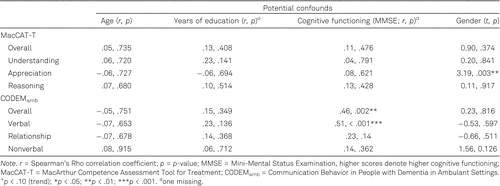
Discussion
The current study aimed to investigate the associations of different aspects of communication behavior, i.e., verbal, nonverbal, and relationship aspects, with the capacity to consent to treatment in PwD.
With our first hypothesis, we investigated whether verbal aspects of communication have stronger associations with MacCAT-T overall scores and its individual subscales than the two nonverbal aspects of communication. This hypothesis was partly supported.
On the one hand, as expected, only the verbal communication behavior was significantly associated with the MacCAT-T overall score as well as the criteria of understanding and reasoning, while the associations of nonverbal and relationship aspects of communication were nonsignificant for the MacCAT-T overall score as well as for the individual criteria. This is in line with the idea put forward by different authors that instruments like the MacCAT-T largely rely on the verbal aspects of communication (Gurrera et al., 2006; Haberstroh, Müller, & Knebel, 2014).
On the other hand, the differences between the correlation coefficients of verbal and both nonverbal and relationship of communication behavior did not reach significance. We should note that we observed a trend in the expected direction for the differences between the verbal and the nonverbal correlation coefficients. This is highly relevant since, in this case, the calculation of the test statistic is highly dependent on sample size, making it difficult to attain significance in small samples like the one used in the current study. Because this is a major limitation of this study, further large-scale studies are needed to clarify the finding.
Furthermore, the criterion of appreciation was not associated with any aspect of communication, which is in line with previous studies (Müller et al., 2017). The comparably weak correlation of communication scores with appreciation may reflect the stronger association of appreciation with general attitudes, such as individual perspectives toward disease and aging, trust in physicians and the healthcare system, or need for autonomy, than with aspects of communication (Müller et al., 2017).
By our second hypothesis, we investigated whether we could observe differences in communication behavior between PwD capable and those incapable of consent. This hypothesis was partly supported. There were no significant differences between both groups, but, descriptively, we observed slightly higher scores for the verbal and relationship aspects of communication in those capable of consent. At the same time, both groups’ scores for the nonverbal aspects of communication and their overall scores were similar. This lends tentative support to our assumptions, though it must be noted that only a small subsample of participants could consent. Inferential statistics with such small sample sizes have to be interpreted cautiously. Therefore, we highly recommend a replication study with larger sample sizes, particularly including more participants with unimpaired capacity to consent.
In further analyses, we explored the role of potential confounds, i.e., age, gender, education, and cognitive status. We found that higher cognitive functioning was related to higher overall CODEMamb-scores and to the verbal subscale scores. This is in line with the findings of earlier studies that the MMSE relies largely on patients’ verbal abilities (Haberstroh, Müller, Knebel, Kaspar, et al., 2014). The findings thus reflect a methodological issue shared with the MacCAT-T.
In summary, our findings suggest that verbal aspects of communication have a higher relevance for current assessments of capacity to consent than nonverbal aspects. Many PwD struggle with this aspect of communication behavior already in the early stages of their disease (Kümmel et al., 2014). In contrast, their communication resources are found more often in nonverbal and relationship aspects of communication. Consequently, PwD cannot show their potential to give informed consent when instruments like the MacCAT-T are used without support, as in this study.
Conceptual Implications
The results of the current study suggest that tools for assessing the capacity to consent are mainly associated with verbal aspects of communication. Moreover, most of the current support strategies for empowering PwD target their understanding of relevant (verbal) information to make a sound treatment decision. However, nonverbal and relationship aspects of the consent situation are also of major relevance for PwDs’ treatment decisions.
Indeed, it has been suggested that PwD base their treatment decision only in a small part on the (rational) information given to them by the medical personnel. For example, Kongsholm and Kappel (2017) forwarded the idea of information-based and trust-based consent, with the former relating to predominantly verbal content aspects of communication and the latter to relationship aspects. They assume that a decision to consent may not be based solely on the information provided but rather on the trust somebody holds in the informing person or institution. Therefore, both information and trust are vital parts of a person’s consent. This means that, although understanding and processing of verbal information are necessary, consent is given only to a trusted person with whom a positive relationship has been established (Hansson, 2005; see also Müller et al., 2017), strengthening the relevance of relationship aspects of communication. Indeed, Poth (2018) show that the presence of a trusted person can support PwD in informed consent procedures. This leads to the following important future research questions: How do PwD come to a treatment decision? How may trust enhance informed consent procedures and support decision-making?
Practical Implications
When assessing the capacity to consent, one must consider not only the assessment situation as a whole and the individual PwD’s communication weaknesses but also – and most notably – their resources (DGGG, DGPPN, & DGN, 2020; Haberstroh et al., 2021). The CODEMamb assessment could provide information about communication resources to be used in the consultation process. Adapting to the resources of PwD could mean using non-verbal and relationship-oriented methods of supported decision making, e.g., the presence of a confidant, increasing PwD’s feeling of security and trust, low noise level, and assessment in a familiar environment to reduce stress level and distraction (DGGG, DGPPN, & DGN, 2020). In addition, one could use supported decision-making strategies that facilitate the understanding and retrieval of verbal information, such as the presentation of information in short, thematically grouped segments in plain language, augmented by written summaries. For more information on strategies for supported decision-making, see Wied et al. (2019), Wied, Haberstroh, et al. (2021), and Wied, Poth, et al. (2021). This requires of the medical personnel a resource-oriented attitude toward PwD as well as the readiness for ongoing training on the topic of the capacity to consent and resource-oriented communication. First results by Poth et al. (2023) show the positive effects of supportive strategies on understanding the information in PwD. More studies are required to assess how it affects a PwD’s capacity to consent when the consultation and assessment process is adapted to their individual resources.
Study Limitations and Future Directions
Some limitations of this study need to be mentioned. First, the sample size was rather small, particularly regarding subsample comparisons. Second, the sample was somewhat selective. For example, we excluded participants with a mother language besides German, thus limiting the generalizability of results to other cultures. Moreover, most participants were female, which is representative of the population of PwD (Alzheimer Europe, 2019) but questions the generalizability to the male PwD population. Additionally, a high proportion of patients were diagnosed with mild dementia, with the MMSE pointing toward a mild to moderate cognitive decline. Future studies should specifically target gender and cultural differences in communication behavior and the capacity to consent, and include more participants at different stages of dementia.
Furthermore, one can criticize the CODEMamb for unequal item difficulties depending on the specific aspect of communication behavior. In fact, the nonverbal items involve both formal testing and observation. The tests require the participant to consider verbal and visual information simultaneously. However, dual tasking is usually difficult for PwD (Haberstroh, Neumeyer, et al., 2011). So these items could be more difficult than the verbal items, which are rated only by observation (Haberstroh et al., 2022). Future studies should address this issue as well, e.g., by investigating the role of item difficulty in nonverbal communication behavior.
Finally, the study used one particular medical decision – about antidementives – as an example to apply the MacCAT-T. Since different treatment decisions may vary in their complexity, our approach sets a similar frame of reference for all participants and, therefore, increases the comparability of the results. It also has high face validity, as the chosen scenario was part of the regular treatment process. Moreover, this real-life scenario has higher ecological validity than fictional scenarios, with which PwD might struggle because of cognitive deficits. However, coming research should consider replicating the results of this study using multiple scenarios.
Conclusions
The results of this study highlight the importance of resource-oriented assessments, possibly using methods of supported decision-making. Future research should investigate the role of nonverbal communication abilities and relationship aspects of communication in PwDs’ capacity to consent, particularly regarding trust in medical personnel and significant others. Not only on legal but also on ethical grounds is it mandatory to enable PwD to exert their right to self-determined decisions for as long as possible in the course of their disease, since every PwD has “the right to a dignified life until its end, including attention to and consideration of individual capabilities to self-determination.” (German Ethics Council, 2012, p. 77).
References
. (2019, January 1). Dementia in Europe Yearbook 2019: Estimating the prevalence of dementia in Europe https://www.alzheimer-europe.org/sites/default/files/alzheimer_europe_dementia_in_europe_yearbook_2019.pdf
(2007). Assessment of patients’ competence to consent to treatment. New England Journal of Medicine, 357(18), 1834–1840. https://doi.org/10.1056/NEJMcp074045
(2006). Multimorbidity in demented and nondemented elderly inpatients: An autopsy study. European Journal of Geriatrics, 8(2), 112–117. https://d-nb.info/999610260/34
(2019). Principles of biomedical ethics (8th ed.). Oxford University Press.
. (2020). Einwilligung von Menschen mit Demenz in medizinische Maßnahmen: Interdisziplinäre S2k-Leitlinie für die medizinische Praxis
[Consent of people with dementia in medical treatments: interdisciplinary S2k-guideline for medical practice] . W. Kohlhammer Verlag.(1975). Mini-mental state. A practical method for grading the cognitive state of patients for the clinician. Journal of Psychiatric Research, 12(3), 189–198. https://doi.org/10.1016/0022-3956(75)90026-6
. (2012). Demenz und Selbstbestimmung: Stellungnahme
[Dementia and self-determination: A statement] . https://www.ethikrat.org/fileadmin/Publikationen/Stellungnahmen/deutsch/stellungnahme-demenz-und-selbstbestimmung.pdf(1998). MacArthur Competence Assessment Tool for Treatment (MacCAT-T). Professional Resource Press.
(2006). Cognitive performance predicts treatment decisional abilities in mild to moderate dementia. Neurology, 66(9), 1367–1372. https://doi.org/10.1212/01.wnl.0000210527.13661.d1
(2017). Einwilligungsfähigkeit bei Demenz
[Capacity to consent in people with dementia] . Zeitschrift für Gerontologie und Geriatrie, 50(4), 298–303. https://doi.org/10.1007/s00391-017-1243-1(2014). Menschen mit Demenz zu selbstbestimmten Entscheidungen über medizinische Maßnahmen befähigen: Das Projekt EmMa
[Empowering people with dementia to self-determined decisions on medical treatments: The EmMa Project] . BtPrax: Betreuungsrechtliche Praxis, 14(5), 195–197.(2014). Can the mini-mental state examination predict capacity to consent to treatment? GeroPsych, 27(4), 151–159. https://doi.org/10.1024/1662-9647/a000113
(2011). TANDEM: Communication training for informal caregivers of people with dementia. Aging & Mental Health, 15(3), 405–413. https://doi.org/10.1080/13607863.2010.536135
(2011). Kommunikation bei Demenz: Ein Ratgeber für Angehörige und Pflegende
[Communication in dementia: A guide for formal and informal caregivers] . Springer Medizin. https://doi.org/10.1007/978-3-642-16843-7(2022). Observational assessment of communication to empower patients with dementia to make legally effective decisions – Revalidation of CODEMamb. Aging & Mental Health, 26(11), 2262–2269. https://doi.org/10.1080/13607863.2021.1952549
(2021). Einwilligungsfähigkeit von Menschen mit Demenz
[Capacity to consent in people with dementia] . Zeitschrift für Gerontologie und Geriatrie, 54(2), 167–175. https://doi.org/10.1007/s00391-020-01820-4(2005). Building on relationships of trust in biobank research. Journal of Medical Ethics, 31(7), 415–418. https://doi.org/10.1136/jme.2004.009456
(2016). Einwilligungsfähigkeit: Inhärente Fähigkeit oder ethisches Urteil?
[Capacity to consent: Inherent ability or ethical judgment?] Ethik in der Medizin, 28(2), 107–120. https://doi.org/10.5167/uzh-114595(2016). CODEMamb – An observational communication behavior assessment tool for use in ambulatory dementia care. Aging & Mental Health, 20(12), 1286–1296. https://doi.org/10.1080/13607863.2015.1075959
(2017). Is consent based on trust morally inferior to consent based on information? Bioethics, 31(6), 432–442. https://doi.org/10.1111/bioe.12342
(2014). CODEM instrument: Developing a tool to assess communication behavior in dementia. GeroPsych, 27(1), 23–31. https://doi.org/10.1024/1662-9647/a000100
(1996). Toward a neurologic model of competency: Cognitive predictors of capacity to consent in Alzheimer’s disease using three different legal standards. Neurology, 46(3), 666–672. https://doi.org/10.1212/WNL.46.3.666
(1997). Consistency of physician judgments of capacity to consent in mild Alzheimer’s disease. Journal of the American Geriatrics Society, 45(4), 453–457. https://doi.org/10.1111/j.1532-5415.1997.tb05170.x
(2006). Neuropsychological predictors of decision-making capacity over 9 months in mild-to-moderate dementia. Journal of General Internal Medicine, 21(1), 78–83. https://doi.org/10.1111/j.1525-1497.2005.00288.x
(2017). Assessing capacity to consent to treatment with cholinesterase inhibitors in dementia using a specific and standardized version of the MacArthur Competence Assessment Tool (MacCAT-T). International Psychogeriatrics, 29(2), 333–343. https://doi.org/10.1017/S104161021600154X
(2015). Comparison of three different assessments of capacity to consent in dementia patients. GeroPsych, 28(1), 21–29. https://doi.org/10.1024/1662-9647/a000119
(2018). Wirkmechanismen von Vertrauen bei der Beurteilung der Einwilligungsfähigkeit von Menschen mit Demenz
[Mechanisms of trust in the assessment of capacity to consent in people with dementia] [Unpublished bachelor’s thesis] . Johann Wolfgang Goethe University, Frankfurt am Main.(2023). Empowering patients with dementia to make legally effective decisions: A randomized controlled trial on enhancing capacity to consent to treatment. Aging & Mental Health, 27(2), 292–300. https://doi.org/10.1080/13607863.2021.2024797
(2012). Facial expression in Alzheimer’s disease: Impact of cognitive deficits and neuropsychiatric symptoms. American Journal of Alzheimer’s Disease & Other Dementias, 27(2), 100–106. https://doi.org/10.1016/0022-3956(75)90026-6
(2018). Psychotherapie-Ethik
[Ethics of psychotherapy] . Hogrefe. https://doi.org/10.1026/02841-000. (2006, December 6). United Nations convention on the rights of persons with disabilities. https://www.un.org/disabilities/documents/convention/convoptprot-e.pdf
(2008). Patientenselbstbestimmung und Selbstbestimmungsfähigkeit: Beiträge zur klinischen Ethik
[Patient autonomy and capacity to consent: Contributions to medical ethics] . Kohlhammer. https://doi.org/10.1007/s00481–009-0042–7. (2021, September 1). Global status report on the public health response to dementia. https://www.who.int/publications/i/item/9789240033245
. (2021). Supported decision-making in persons with dementia: Development of an enhanced consent procedure for lumbar puncture. Frontiers in Psychiatry, 12, Article
780276 . https://doi.org/10.3389/fpsyt.2021.780276(2019). The human right to make one’s own choices – Implications for supported decision-making in persons with dementia: A systematic review. European Psychologist, 24(2), 146–158. https://doi.org/10.1027/1016-9040/a000372
. (2021). How do dementia researchers view support tools for informed consent procedures of persons with dementia. Zeitschrift für Gerontologie und Geriatrie, 54(7), 667–675. https://doi.org/10.1007/s00391-020-01779-2
(2012). Examining success of communication strategies used by formal caregivers assisting individuals with Alzheimer’s disease during an activity of daily living. Journal of Speech, Language, and Hearing Research, 55(2), 328–341. https://doi.org/10.1044/1092-4388(2011/10-0206)

